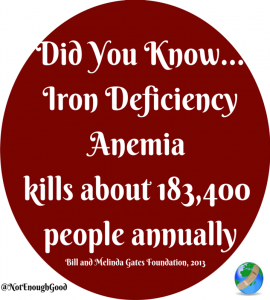I was a junior in high school and 17 years old when I first heard the term anemia. In California, where I live you have to be at least 110 pounds to give blood, I finally got to that weight and was energized to give blood and give back to the community. So the blood drive staff pricked my finger as they do to all the blood donors and told me I had anemia. Their solution, go eat lunch, then come back and try again.
The next time I heard the term was about 3 years later when I was 20 years old during my annual OB/Gyn visit. Because I had missed a few menstrual periods they ran blood work. My Nurse Practitioner didn’t feel anything was wrong with me but did the blood tests just to see. I received a call the next day and was informed I was iron deficient and anemic. After hearing this diagnosis I researched all I could about my disorder.
and anemic. After hearing this diagnosis I researched all I could about my disorder.
Iron Deficiency Anemia (IDA) is the most common type of anemia and occurs when an individual does not have enough iron minerals in their blood. There are different reasons why this occurs including blood loss, pregnancy, not eating enough iron rich foods, and internal bleeding. Though, It can occur in men and women, some groups are at greater risk. For example vegetarians, infants, and children who may not get enough iron in their diet. Other groups such as those who give blood frequently, pregnant women and women 21-41 years old are also high risk populations. Individuals can experience IDA symptoms for years without knowing the cause.
During my follow up visit, my doctor did a bit more than tell me to go eat something, they told me to get some folic acid and some iron pills and to keep taking them. I also saw a hematologist, and was quickly faced with the reality of having IDA. The way the doctor described it, I was running on fumes, like if a car was running on its last legs of gas. IDA doesn’t sound so threatening, but it is the most common nutritional disorder in the world and can be life threatening .
IDA contributes to 841,000 deaths per year. My doctor told me the first day in her office that if I did not get this resolved quickly, I would be dead by the time I was 22 years old. I was already in shock from how anemic I was, how sick I really was and didn’t know it.
Sometimes you have to laugh because otherwise you cry. We had been driving home that night and a car cut us off on the freeway. I remember saying “Excuse me, I still have two more years to live” I think I needed to make it lighter somehow.
There are many different ways to treat iron deficiency anemia depending on how severe and the causes of IDA. You can treat it with oral supplements, changing your dietary habits to include more iron rich foods. For the more severe cases, you may need blood transfusions, surgery or iron infusions. My doctor had me do iron infusions, so they pumped Iron into me. The very first day after my first round of medication I felt different, it helped instantly in the same day. I noticed more color in my cheeks and I wasn’t as tired as I had been before.
can treat it with oral supplements, changing your dietary habits to include more iron rich foods. For the more severe cases, you may need blood transfusions, surgery or iron infusions. My doctor had me do iron infusions, so they pumped Iron into me. The very first day after my first round of medication I felt different, it helped instantly in the same day. I noticed more color in my cheeks and I wasn’t as tired as I had been before.
I encourage all of you readers to ask questions, do more research, and share this information with your friends and family. This is a disorder that can be fixed, it can be fixed and stable before it does serious harm, it can even be dealt with before you have to worry about having low oxygen counts. You can make a difference by being educated and bring questions up to your doctors. I know this because I am now 26 years old and my health has improved immensely. Let’s all work together to find a way to make this disorder disappear.



1 pings